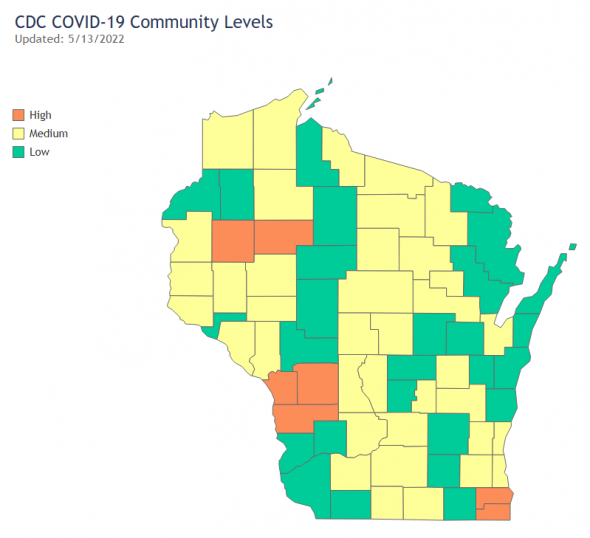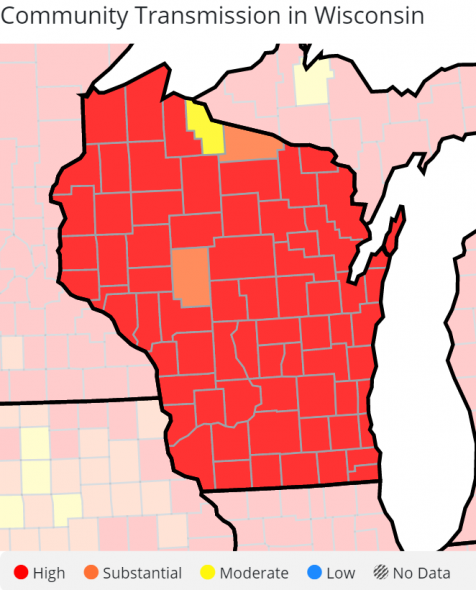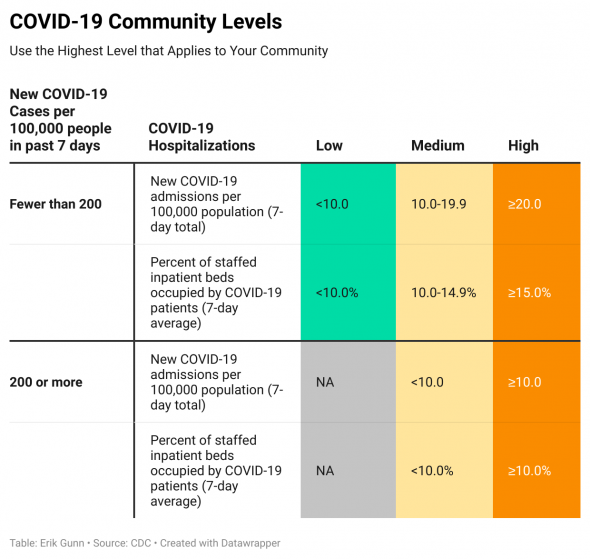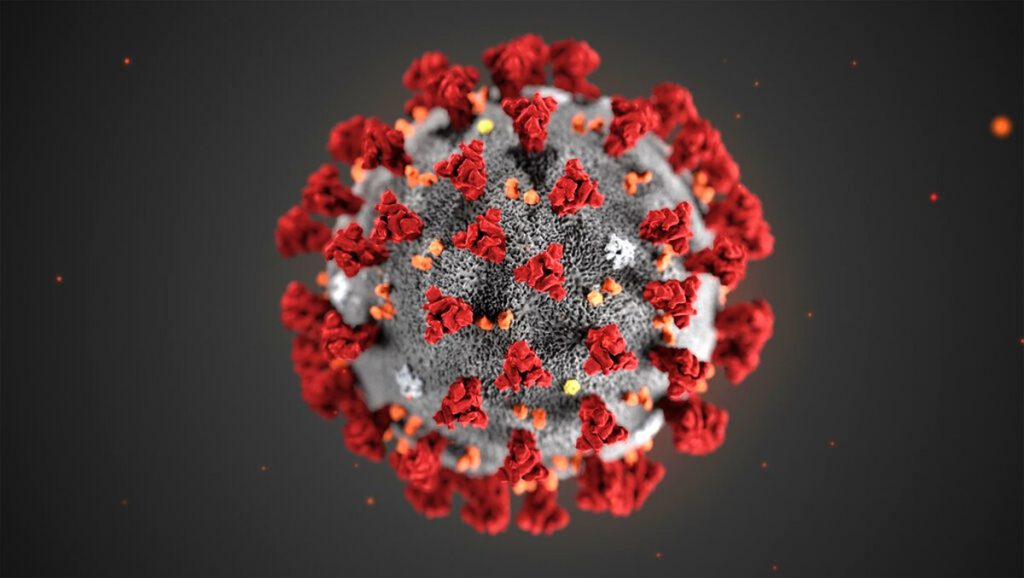State’s COVID-19 Cases Up 66% in May
Racine and Kenosha among 7 counties with highest rates, residents urged to wear masks at indoor events.
With another surge in COVID-19 infections, new cases and hospitalizations in seven Wisconsin counties are high enough combined that new federal guidelines call for everyone to wear masks when gathering indoors.
In those counties, “there’s enough community transmission that the number of cases is high,” said Dr. Ryan Westergaard of the Wisconsin Department of Health Services (DHS) in an online briefing on Monday. “And there’s a larger number of people with COVID-19 in our hospitals.” The combination is a signal that “we need to be working a little harder than we had been to prevent transmission.”
But the new variants are even more contagious, so much so that “being in the same room with a person who’s infected is now a risk factor,” he said. “It’s no longer that you’re within six feet for 15 minutes” in order to risk contracting the virus.
DHS is urging unvaccinated people to get vaccinated and fully vaccinated people to get a booster shot if they haven’t yet done so.
The latest county-specific recommendations are the result of a system for rating local COVID-19 risk that the federal Centers for Disease Control and Prevention (CDC) introduced in February. The so-called “community level” ratings combine data about increases in positive cases with data on hospitalizations of patients with COVID-19 to designate whether a county’s level is “low,” “medium” or “high.”

This CDC graphic, posted by the Wisconsin Department of Health Services (DHS), shows counties’ “COVID-19 community level” as of Friday, May 13: Low (green), Medium (yellow) or High (Orange). See table at the end of this story for the threshold statistics used to assign a county’s community level. CDC graphic via DHS.
In counties with “high” community levels, the federal agency recommends masking for everyone in doors, whether or not they have been vaccinated. As of the weekend, Barron, Rusk, La Crosse, Monroe, Vernon, Racine and Kenosha counties all had high community levels using the new CDC guidance.
Another 38 Wisconsin counties now have “medium” community levels, where the CDC recommends that people who may be more vulnerable to the virus responsible for COVID-19 consult with health providers about the possibility of wearing a mask.
The state’s remaining 27 counties still have a low community level. There, the federal and state recommendations focus on getting COVID-19 vaccines and boosters up to date.
Across the state, said Westergaard, the availability of COVID-19 vaccines and the temporary authorization for new anti-viral drugs to treat people who have been infected both can reduce the severity and the risk of death from the illness.
As infections rise, he said, “people need to know about these tools — they need to talk to their health care professionals to make sure that they’re up to date on their vaccines.”
And for people who do test positive and whose age or medical history puts them at higher risk for illness from the virus, DHS is urging health care providers and their patients to turn to the newly available drugs, including Paxlovid, “because it can save lives,” Westergaard added.
Measuring the pandemic
The CDC’s shift to measuring the severity of COVID-19 using the new “community level” system has drawn criticism from some public health specialists and scientists studying the trajectory of the pandemic.
The measurement scale has raised the thresholds for infection rates that trigger a more severe assessment. In addition, hospitalization rates that are part of the new scale don’t show up as strongly until an outbreak is underway.

This CDC graphic shows levels of community transmission of COVID-19 in each county as of Sunday, May 15. It shows all but three counties with “High” levels of transmission, and does not distinguish among counties based on the burden on their local or regional hospital systems. CDC graphic.
The community level measurement paints a much less dramatic level of illness than community transmission data, upon which the CDC previously relied and which it continues to track. That data shows the spread of disease as universally high throughout Wisconsin.
“I think the intent of that updated [community level] approach was a good one,” says Dr. Geoffrey Swain, president of the Wisconsin Public Health Association. It recognized, Swain says, that public health in general doesn’t focus on mild illness. “I think what the CDC was trying to say is that a lot of people are getting COVID but a lot of people aren’t in the hospital.”
The drawback, Swain says, is that hospitalizations “significantly lag cases,” showing up two weeks after a surge in case numbers, with deaths showing up another two to three weeks later.
From April 17 to May 1, the number of average daily cases doubled statewide, while hospitalizations “were pretty flat,” Swain says. But in the first two weeks of May, cases rose 66% and hospitalizations rose 50% — a big shift.
Westergaard said Monday that the CDC’s new approach was developed because as more people relied on home tests, the results of which aren’t typically reported in the state or local COVID case counts, case counts by themselves have become underreported.
The community level measurement gives “more attention to critical resources,” he said, including whether hospitals are overwhelmed, making it possible to measure the stress that COVID-19 is placing on the health care system.
“If we see it going to a level where our health care system is at risk or the transmission gets very, very high, we can take collective action and intensify some of our prevention measures,” such as encouraging indoor masking, Westergaard said.
So far, he said, while more people are being hospitalized, the increase “is very small in comparison to what we were experiencing in January,” when a surge in cases resulted in more than 2,000 people being hospitalized at a time.
‘You should start wearing a mask now’
Regardless of the CDC’s community level guidance, Swain says the continued spread of COVID-19 warrants much more masking across the board.

This table shows how the CDC’s community level ratings are established. Click on the image to see the graphic enlarged in a new window.
“The CDC community levels are very lax,” Swain says. “So if you are living in a county that’s ‘high’ on this measure, you can be sure that that county’s in trouble from COVID.”
In a county where the community level isn’t high yet, he urges “paying close attention, because COVID cases are going up all across the state.” In the six weeks from April 3 to May 15, cases jumped from 213 on average a day to 2,193 — a 10-fold jump.
With hospitalizations rising, too, he adds, “You should start getting yourself psychologically ready to put the mask back on.”
And people who are willing to mask indoors now, even if the county where they live isn’t yet at a high level, “should do it, and you should wear a high quality mask,” Swain says. “You should start wearing a mask now, because there’s a lot of COVID around.”
COVID-19 cases rise again, testing CDC’s new assessment tool was originally published by the Wisconsin Examiner.
More about the Coronavirus Pandemic
- Governors Tony Evers, JB Pritzker, Tim Walz, and Gretchen Whitmer Issue a Joint Statement Concerning Reports that Donald Trump Gave Russian Dictator Putin American COVID-19 Supplies - Gov. Tony Evers - Oct 11th, 2024
- MHD Release: Milwaukee Health Department Launches COVID-19 Wastewater Testing Dashboard - City of Milwaukee Health Department - Jan 23rd, 2024
- Milwaukee County Announces New Policies Related to COVID-19 Pandemic - David Crowley - May 9th, 2023
- DHS Details End of Emergency COVID-19 Response - Wisconsin Department of Health Services - Apr 26th, 2023
- Milwaukee Health Department Announces Upcoming Changes to COVID-19 Services - City of Milwaukee Health Department - Mar 17th, 2023
- Fitzgerald Applauds Passage of COVID-19 Origin Act - U.S. Rep. Scott Fitzgerald - Mar 10th, 2023
- DHS Expands Free COVID-19 Testing Program - Wisconsin Department of Health Services - Feb 10th, 2023
- MKE County: COVID-19 Hospitalizations Rising - Graham Kilmer - Jan 16th, 2023
- Not Enough Getting Bivalent Booster Shots, State Health Officials Warn - Gaby Vinick - Dec 26th, 2022
- Nearly All Wisconsinites Age 6 Months and Older Now Eligible for Updated COVID-19 Vaccine - Wisconsin Department of Health Services - Dec 15th, 2022
Read more about Coronavirus Pandemic here




















